University Finance Report: Investment Appraisal and Business Finance
VerifiedAdded on 2022/10/16
|10
|2415
|17
Report
AI Summary
This report delves into the critical domain of business finance, focusing on the multifaceted process of investment appraisal. It meticulously outlines various methods employed to assess the viability and attractiveness of potential investments, including the payback period, accounting rate of return, discounted cash flow, net present value (NPV), internal rate of return (IRR), and profitability index. Each technique is elucidated, with practical examples demonstrating their application and comparative advantages. The report further examines the suitability of these methods in a dynamic business environment, considering factors such as taxation, inflation, and stakeholder needs. It emphasizes the significance of investment appraisal in aligning with a company's long-term strategic goals and its responsibility towards investors and the wider community. By analyzing the impact of market changes and globalization, the report underscores the importance of flexibility, innovation, and a clear vision for future business strategies. The report also references academic sources to support its findings, providing a comprehensive overview of the investment appraisal process and its implications for business success. The report highlights the importance of investment appraisal for creating measurability and accountability for a business.
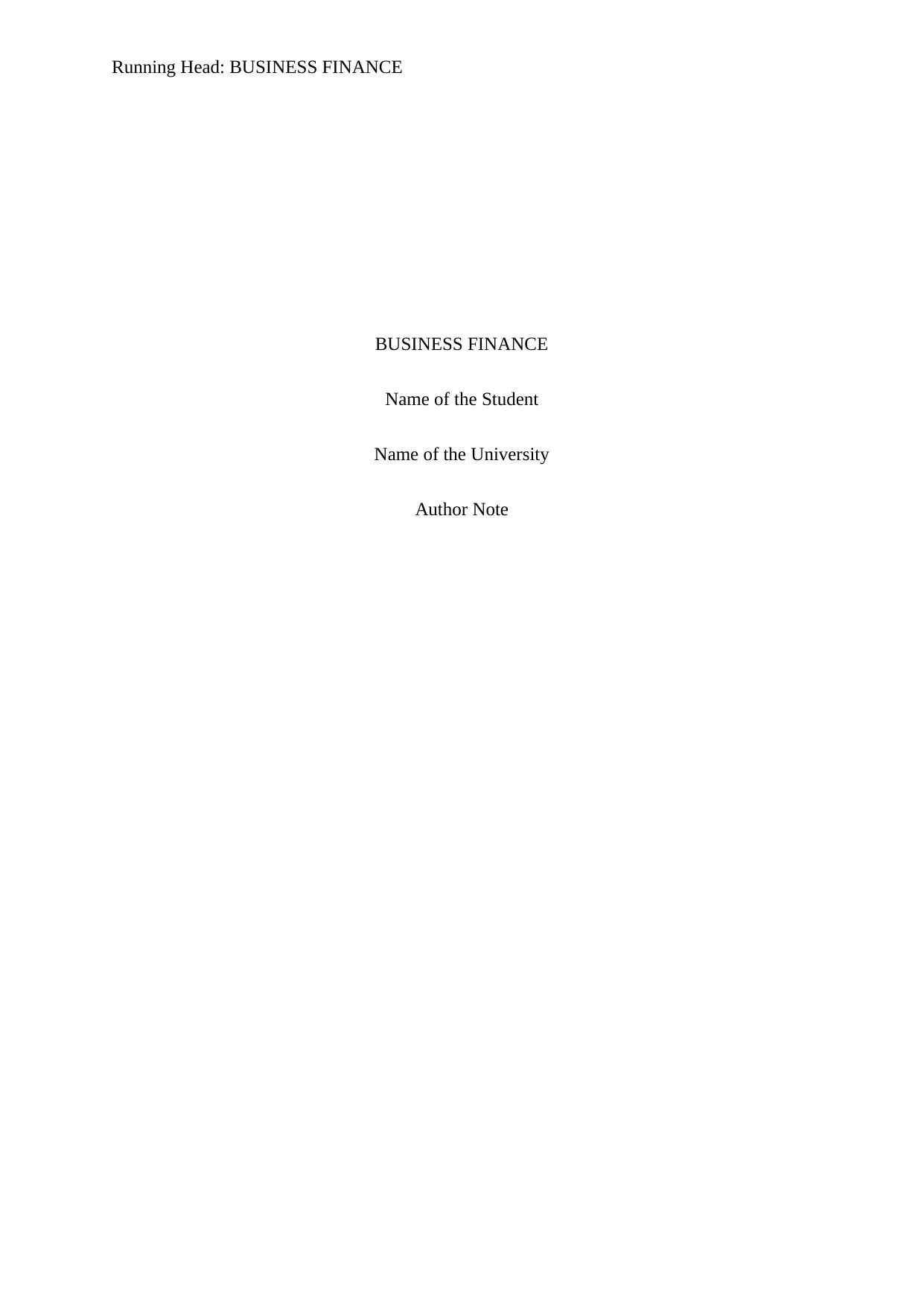
Running Head: BUSINESS FINANCE
BUSINESS FINANCE
Name of the Student
Name of the University
Author Note
BUSINESS FINANCE
Name of the Student
Name of the University
Author Note
Paraphrase This Document
Need a fresh take? Get an instant paraphrase of this document with our AI Paraphraser

1BUSINESS FINANCE
Table of Contents
Business Finance........................................................................................................................2
Reference....................................................................................................................................8
Table of Contents
Business Finance........................................................................................................................2
Reference....................................................................................................................................8
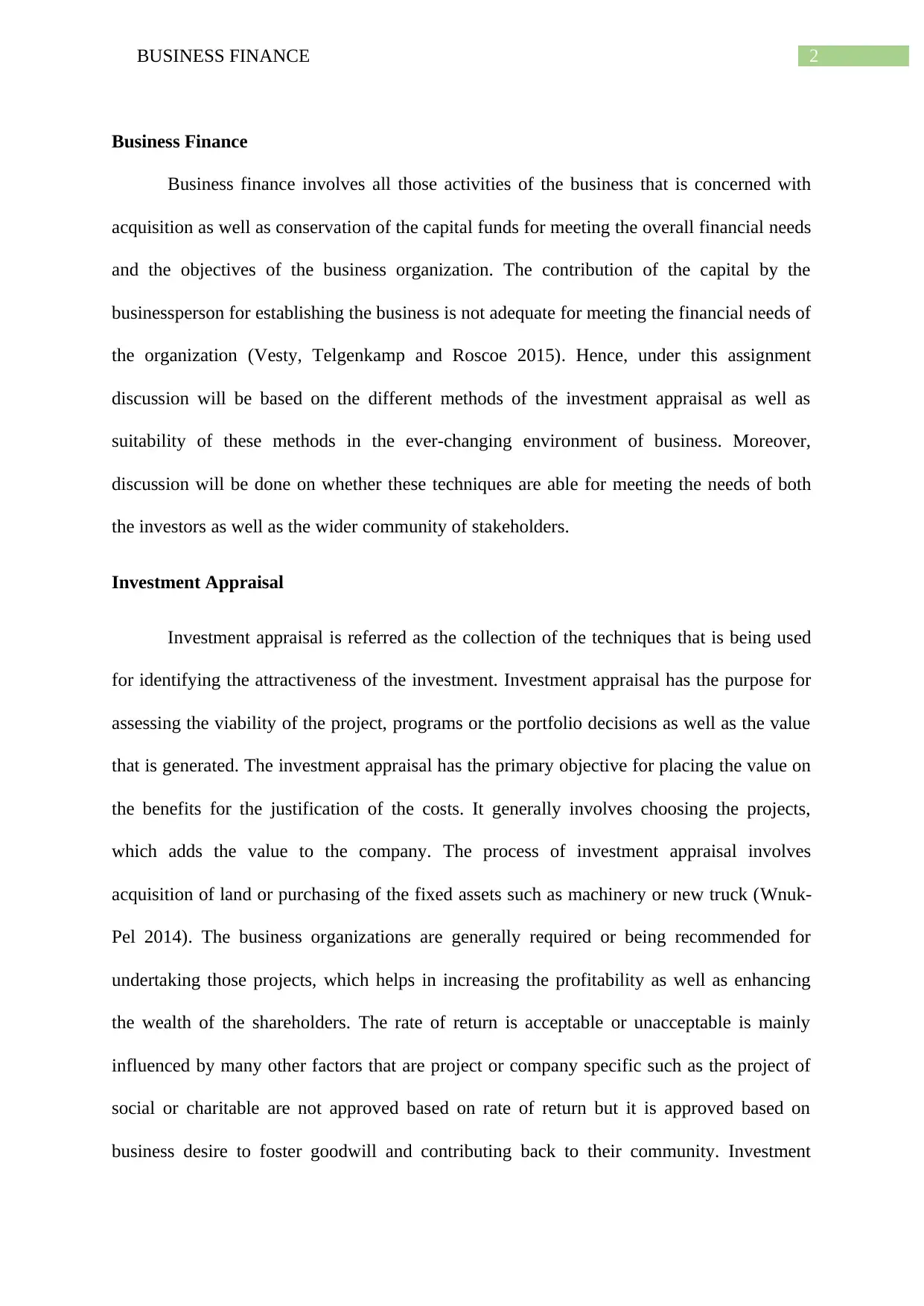
2BUSINESS FINANCE
Business Finance
Business finance involves all those activities of the business that is concerned with
acquisition as well as conservation of the capital funds for meeting the overall financial needs
and the objectives of the business organization. The contribution of the capital by the
businessperson for establishing the business is not adequate for meeting the financial needs of
the organization (Vesty, Telgenkamp and Roscoe 2015). Hence, under this assignment
discussion will be based on the different methods of the investment appraisal as well as
suitability of these methods in the ever-changing environment of business. Moreover,
discussion will be done on whether these techniques are able for meeting the needs of both
the investors as well as the wider community of stakeholders.
Investment Appraisal
Investment appraisal is referred as the collection of the techniques that is being used
for identifying the attractiveness of the investment. Investment appraisal has the purpose for
assessing the viability of the project, programs or the portfolio decisions as well as the value
that is generated. The investment appraisal has the primary objective for placing the value on
the benefits for the justification of the costs. It generally involves choosing the projects,
which adds the value to the company. The process of investment appraisal involves
acquisition of land or purchasing of the fixed assets such as machinery or new truck (Wnuk-
Pel 2014). The business organizations are generally required or being recommended for
undertaking those projects, which helps in increasing the profitability as well as enhancing
the wealth of the shareholders. The rate of return is acceptable or unacceptable is mainly
influenced by many other factors that are project or company specific such as the project of
social or charitable are not approved based on rate of return but it is approved based on
business desire to foster goodwill and contributing back to their community. Investment
Business Finance
Business finance involves all those activities of the business that is concerned with
acquisition as well as conservation of the capital funds for meeting the overall financial needs
and the objectives of the business organization. The contribution of the capital by the
businessperson for establishing the business is not adequate for meeting the financial needs of
the organization (Vesty, Telgenkamp and Roscoe 2015). Hence, under this assignment
discussion will be based on the different methods of the investment appraisal as well as
suitability of these methods in the ever-changing environment of business. Moreover,
discussion will be done on whether these techniques are able for meeting the needs of both
the investors as well as the wider community of stakeholders.
Investment Appraisal
Investment appraisal is referred as the collection of the techniques that is being used
for identifying the attractiveness of the investment. Investment appraisal has the purpose for
assessing the viability of the project, programs or the portfolio decisions as well as the value
that is generated. The investment appraisal has the primary objective for placing the value on
the benefits for the justification of the costs. It generally involves choosing the projects,
which adds the value to the company. The process of investment appraisal involves
acquisition of land or purchasing of the fixed assets such as machinery or new truck (Wnuk-
Pel 2014). The business organizations are generally required or being recommended for
undertaking those projects, which helps in increasing the profitability as well as enhancing
the wealth of the shareholders. The rate of return is acceptable or unacceptable is mainly
influenced by many other factors that are project or company specific such as the project of
social or charitable are not approved based on rate of return but it is approved based on
business desire to foster goodwill and contributing back to their community. Investment
⊘ This is a preview!⊘
Do you want full access?
Subscribe today to unlock all pages.

Trusted by 1+ million students worldwide
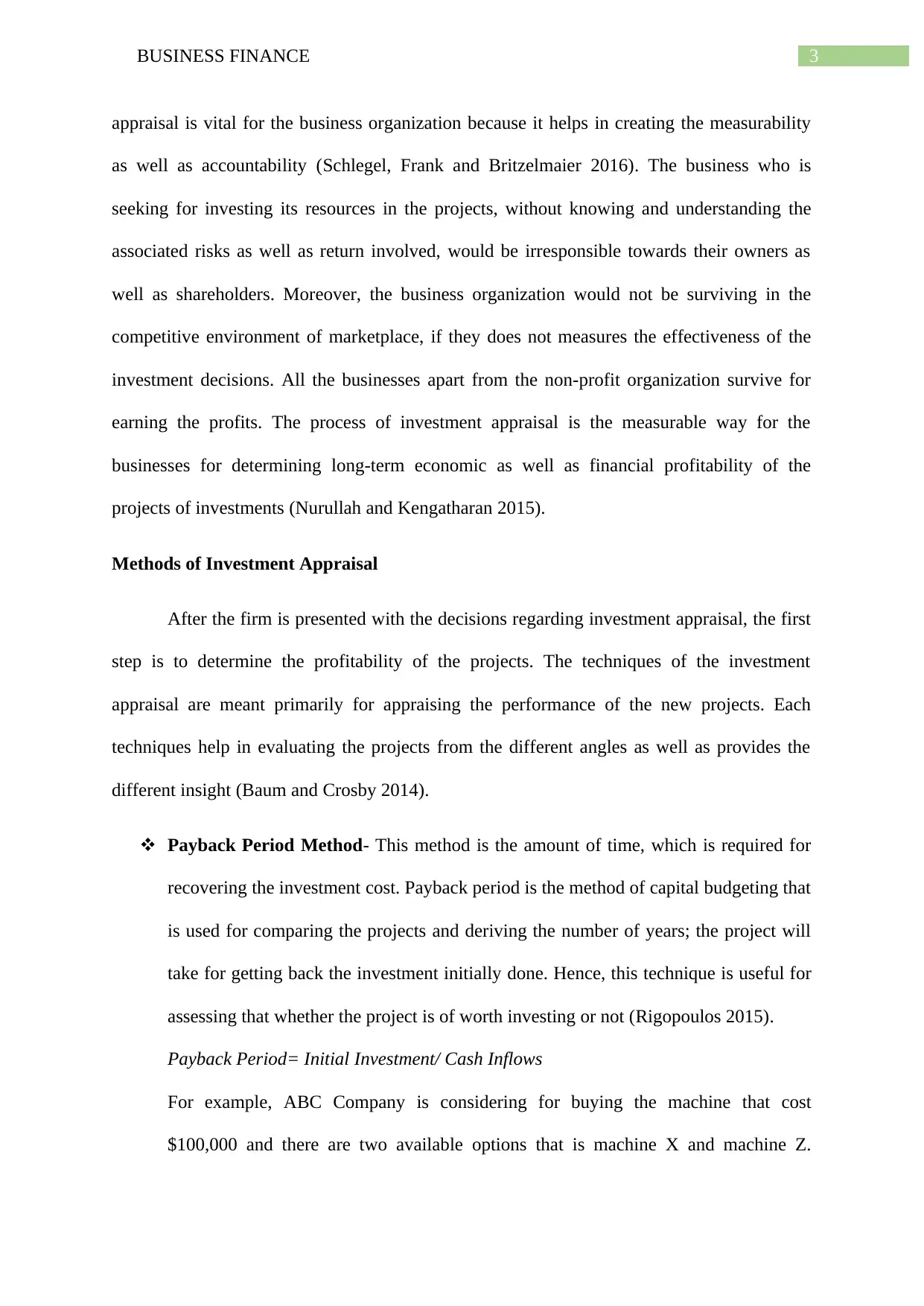
3BUSINESS FINANCE
appraisal is vital for the business organization because it helps in creating the measurability
as well as accountability (Schlegel, Frank and Britzelmaier 2016). The business who is
seeking for investing its resources in the projects, without knowing and understanding the
associated risks as well as return involved, would be irresponsible towards their owners as
well as shareholders. Moreover, the business organization would not be surviving in the
competitive environment of marketplace, if they does not measures the effectiveness of the
investment decisions. All the businesses apart from the non-profit organization survive for
earning the profits. The process of investment appraisal is the measurable way for the
businesses for determining long-term economic as well as financial profitability of the
projects of investments (Nurullah and Kengatharan 2015).
Methods of Investment Appraisal
After the firm is presented with the decisions regarding investment appraisal, the first
step is to determine the profitability of the projects. The techniques of the investment
appraisal are meant primarily for appraising the performance of the new projects. Each
techniques help in evaluating the projects from the different angles as well as provides the
different insight (Baum and Crosby 2014).
Payback Period Method- This method is the amount of time, which is required for
recovering the investment cost. Payback period is the method of capital budgeting that
is used for comparing the projects and deriving the number of years; the project will
take for getting back the investment initially done. Hence, this technique is useful for
assessing that whether the project is of worth investing or not (Rigopoulos 2015).
Payback Period= Initial Investment/ Cash Inflows
For example, ABC Company is considering for buying the machine that cost
$100,000 and there are two available options that is machine X and machine Z.
appraisal is vital for the business organization because it helps in creating the measurability
as well as accountability (Schlegel, Frank and Britzelmaier 2016). The business who is
seeking for investing its resources in the projects, without knowing and understanding the
associated risks as well as return involved, would be irresponsible towards their owners as
well as shareholders. Moreover, the business organization would not be surviving in the
competitive environment of marketplace, if they does not measures the effectiveness of the
investment decisions. All the businesses apart from the non-profit organization survive for
earning the profits. The process of investment appraisal is the measurable way for the
businesses for determining long-term economic as well as financial profitability of the
projects of investments (Nurullah and Kengatharan 2015).
Methods of Investment Appraisal
After the firm is presented with the decisions regarding investment appraisal, the first
step is to determine the profitability of the projects. The techniques of the investment
appraisal are meant primarily for appraising the performance of the new projects. Each
techniques help in evaluating the projects from the different angles as well as provides the
different insight (Baum and Crosby 2014).
Payback Period Method- This method is the amount of time, which is required for
recovering the investment cost. Payback period is the method of capital budgeting that
is used for comparing the projects and deriving the number of years; the project will
take for getting back the investment initially done. Hence, this technique is useful for
assessing that whether the project is of worth investing or not (Rigopoulos 2015).
Payback Period= Initial Investment/ Cash Inflows
For example, ABC Company is considering for buying the machine that cost
$100,000 and there are two available options that is machine X and machine Z.
Paraphrase This Document
Need a fresh take? Get an instant paraphrase of this document with our AI Paraphraser
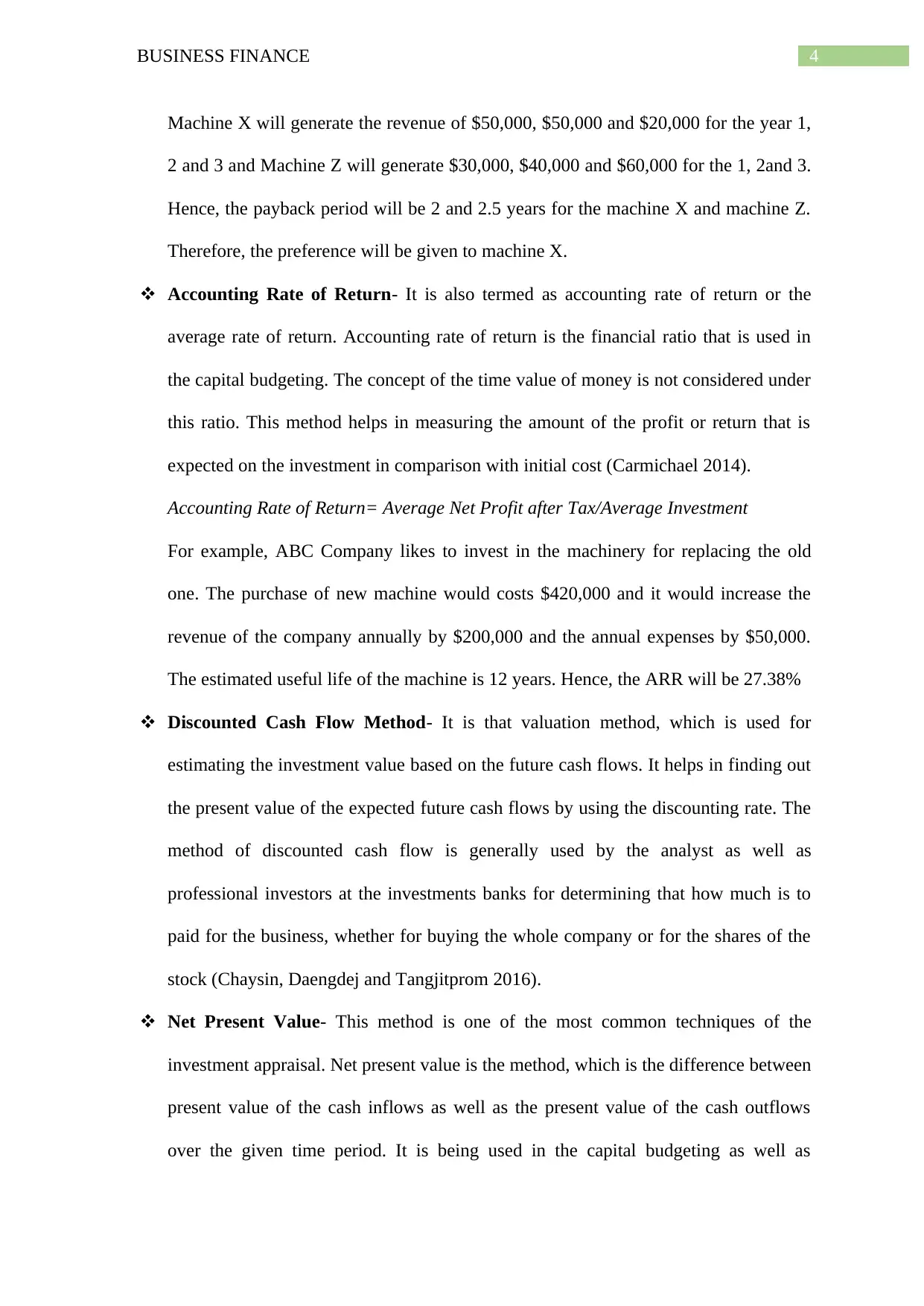
4BUSINESS FINANCE
Machine X will generate the revenue of $50,000, $50,000 and $20,000 for the year 1,
2 and 3 and Machine Z will generate $30,000, $40,000 and $60,000 for the 1, 2and 3.
Hence, the payback period will be 2 and 2.5 years for the machine X and machine Z.
Therefore, the preference will be given to machine X.
Accounting Rate of Return- It is also termed as accounting rate of return or the
average rate of return. Accounting rate of return is the financial ratio that is used in
the capital budgeting. The concept of the time value of money is not considered under
this ratio. This method helps in measuring the amount of the profit or return that is
expected on the investment in comparison with initial cost (Carmichael 2014).
Accounting Rate of Return= Average Net Profit after Tax/Average Investment
For example, ABC Company likes to invest in the machinery for replacing the old
one. The purchase of new machine would costs $420,000 and it would increase the
revenue of the company annually by $200,000 and the annual expenses by $50,000.
The estimated useful life of the machine is 12 years. Hence, the ARR will be 27.38%
Discounted Cash Flow Method- It is that valuation method, which is used for
estimating the investment value based on the future cash flows. It helps in finding out
the present value of the expected future cash flows by using the discounting rate. The
method of discounted cash flow is generally used by the analyst as well as
professional investors at the investments banks for determining that how much is to
paid for the business, whether for buying the whole company or for the shares of the
stock (Chaysin, Daengdej and Tangjitprom 2016).
Net Present Value- This method is one of the most common techniques of the
investment appraisal. Net present value is the method, which is the difference between
present value of the cash inflows as well as the present value of the cash outflows
over the given time period. It is being used in the capital budgeting as well as
Machine X will generate the revenue of $50,000, $50,000 and $20,000 for the year 1,
2 and 3 and Machine Z will generate $30,000, $40,000 and $60,000 for the 1, 2and 3.
Hence, the payback period will be 2 and 2.5 years for the machine X and machine Z.
Therefore, the preference will be given to machine X.
Accounting Rate of Return- It is also termed as accounting rate of return or the
average rate of return. Accounting rate of return is the financial ratio that is used in
the capital budgeting. The concept of the time value of money is not considered under
this ratio. This method helps in measuring the amount of the profit or return that is
expected on the investment in comparison with initial cost (Carmichael 2014).
Accounting Rate of Return= Average Net Profit after Tax/Average Investment
For example, ABC Company likes to invest in the machinery for replacing the old
one. The purchase of new machine would costs $420,000 and it would increase the
revenue of the company annually by $200,000 and the annual expenses by $50,000.
The estimated useful life of the machine is 12 years. Hence, the ARR will be 27.38%
Discounted Cash Flow Method- It is that valuation method, which is used for
estimating the investment value based on the future cash flows. It helps in finding out
the present value of the expected future cash flows by using the discounting rate. The
method of discounted cash flow is generally used by the analyst as well as
professional investors at the investments banks for determining that how much is to
paid for the business, whether for buying the whole company or for the shares of the
stock (Chaysin, Daengdej and Tangjitprom 2016).
Net Present Value- This method is one of the most common techniques of the
investment appraisal. Net present value is the method, which is the difference between
present value of the cash inflows as well as the present value of the cash outflows
over the given time period. It is being used in the capital budgeting as well as
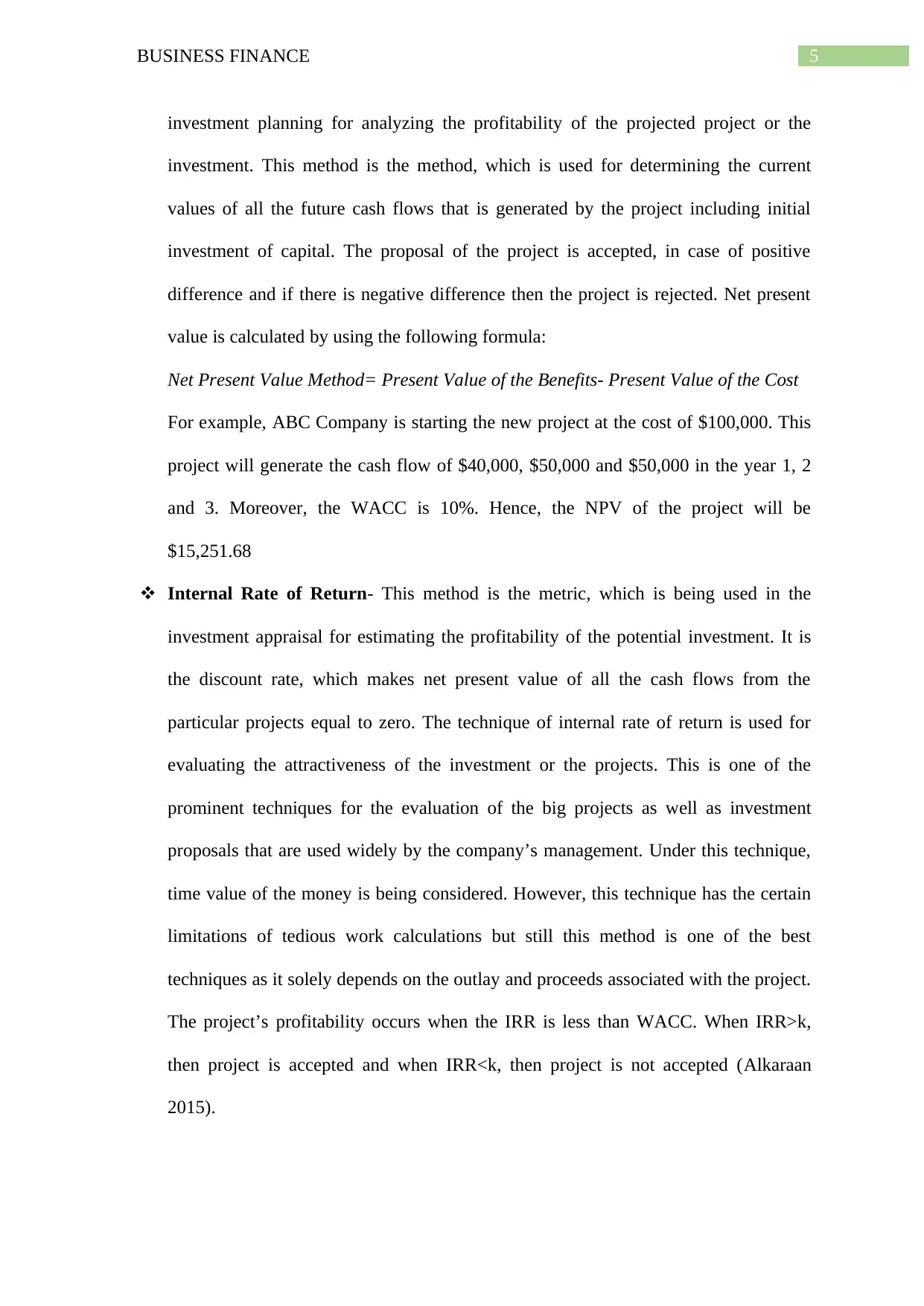
5BUSINESS FINANCE
investment planning for analyzing the profitability of the projected project or the
investment. This method is the method, which is used for determining the current
values of all the future cash flows that is generated by the project including initial
investment of capital. The proposal of the project is accepted, in case of positive
difference and if there is negative difference then the project is rejected. Net present
value is calculated by using the following formula:
Net Present Value Method= Present Value of the Benefits- Present Value of the Cost
For example, ABC Company is starting the new project at the cost of $100,000. This
project will generate the cash flow of $40,000, $50,000 and $50,000 in the year 1, 2
and 3. Moreover, the WACC is 10%. Hence, the NPV of the project will be
$15,251.68
Internal Rate of Return- This method is the metric, which is being used in the
investment appraisal for estimating the profitability of the potential investment. It is
the discount rate, which makes net present value of all the cash flows from the
particular projects equal to zero. The technique of internal rate of return is used for
evaluating the attractiveness of the investment or the projects. This is one of the
prominent techniques for the evaluation of the big projects as well as investment
proposals that are used widely by the company’s management. Under this technique,
time value of the money is being considered. However, this technique has the certain
limitations of tedious work calculations but still this method is one of the best
techniques as it solely depends on the outlay and proceeds associated with the project.
The project’s profitability occurs when the IRR is less than WACC. When IRR>k,
then project is accepted and when IRR<k, then project is not accepted (Alkaraan
2015).
investment planning for analyzing the profitability of the projected project or the
investment. This method is the method, which is used for determining the current
values of all the future cash flows that is generated by the project including initial
investment of capital. The proposal of the project is accepted, in case of positive
difference and if there is negative difference then the project is rejected. Net present
value is calculated by using the following formula:
Net Present Value Method= Present Value of the Benefits- Present Value of the Cost
For example, ABC Company is starting the new project at the cost of $100,000. This
project will generate the cash flow of $40,000, $50,000 and $50,000 in the year 1, 2
and 3. Moreover, the WACC is 10%. Hence, the NPV of the project will be
$15,251.68
Internal Rate of Return- This method is the metric, which is being used in the
investment appraisal for estimating the profitability of the potential investment. It is
the discount rate, which makes net present value of all the cash flows from the
particular projects equal to zero. The technique of internal rate of return is used for
evaluating the attractiveness of the investment or the projects. This is one of the
prominent techniques for the evaluation of the big projects as well as investment
proposals that are used widely by the company’s management. Under this technique,
time value of the money is being considered. However, this technique has the certain
limitations of tedious work calculations but still this method is one of the best
techniques as it solely depends on the outlay and proceeds associated with the project.
The project’s profitability occurs when the IRR is less than WACC. When IRR>k,
then project is accepted and when IRR<k, then project is not accepted (Alkaraan
2015).
⊘ This is a preview!⊘
Do you want full access?
Subscribe today to unlock all pages.

Trusted by 1+ million students worldwide
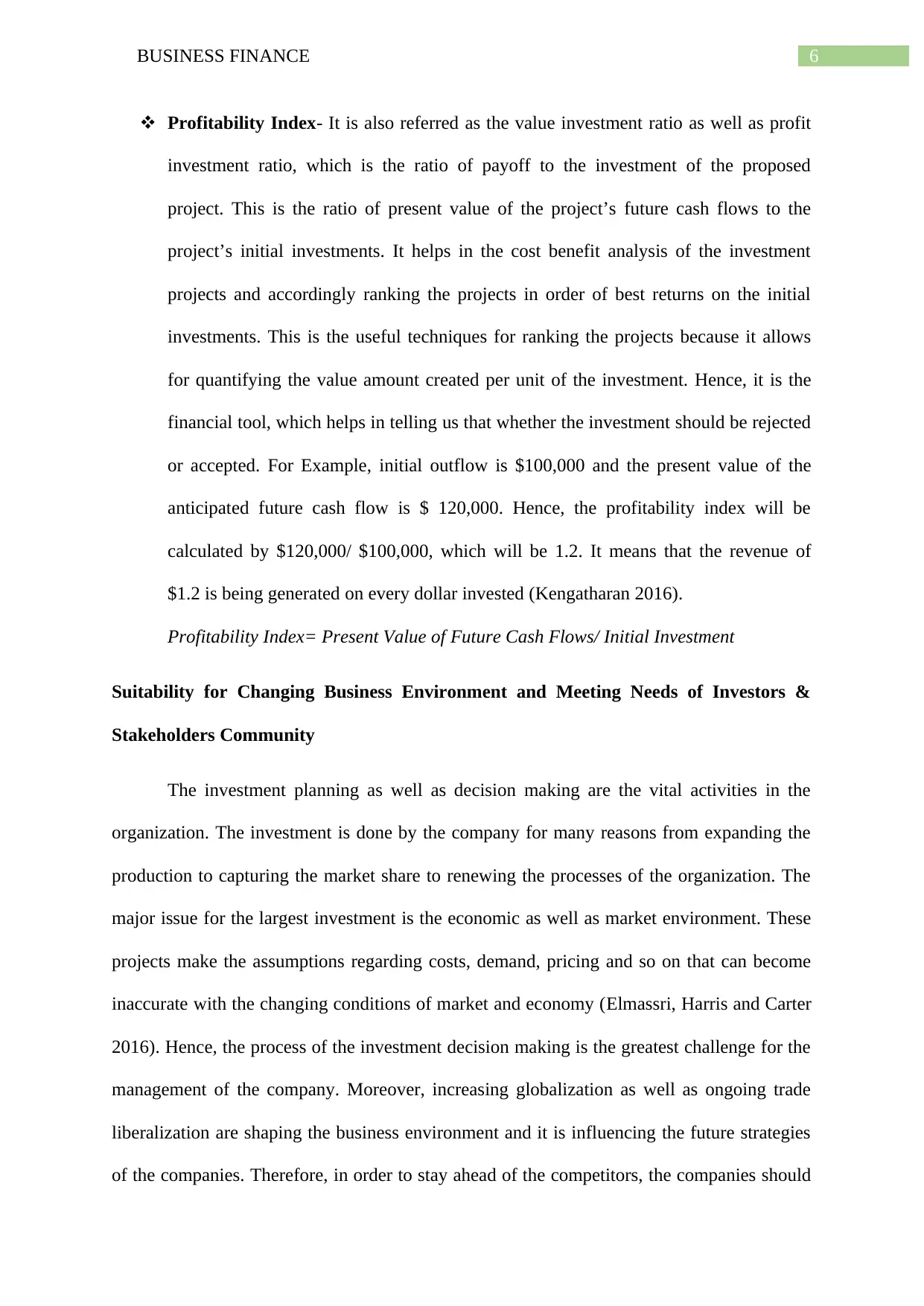
6BUSINESS FINANCE
Profitability Index- It is also referred as the value investment ratio as well as profit
investment ratio, which is the ratio of payoff to the investment of the proposed
project. This is the ratio of present value of the project’s future cash flows to the
project’s initial investments. It helps in the cost benefit analysis of the investment
projects and accordingly ranking the projects in order of best returns on the initial
investments. This is the useful techniques for ranking the projects because it allows
for quantifying the value amount created per unit of the investment. Hence, it is the
financial tool, which helps in telling us that whether the investment should be rejected
or accepted. For Example, initial outflow is $100,000 and the present value of the
anticipated future cash flow is $ 120,000. Hence, the profitability index will be
calculated by $120,000/ $100,000, which will be 1.2. It means that the revenue of
$1.2 is being generated on every dollar invested (Kengatharan 2016).
Profitability Index= Present Value of Future Cash Flows/ Initial Investment
Suitability for Changing Business Environment and Meeting Needs of Investors &
Stakeholders Community
The investment planning as well as decision making are the vital activities in the
organization. The investment is done by the company for many reasons from expanding the
production to capturing the market share to renewing the processes of the organization. The
major issue for the largest investment is the economic as well as market environment. These
projects make the assumptions regarding costs, demand, pricing and so on that can become
inaccurate with the changing conditions of market and economy (Elmassri, Harris and Carter
2016). Hence, the process of the investment decision making is the greatest challenge for the
management of the company. Moreover, increasing globalization as well as ongoing trade
liberalization are shaping the business environment and it is influencing the future strategies
of the companies. Therefore, in order to stay ahead of the competitors, the companies should
Profitability Index- It is also referred as the value investment ratio as well as profit
investment ratio, which is the ratio of payoff to the investment of the proposed
project. This is the ratio of present value of the project’s future cash flows to the
project’s initial investments. It helps in the cost benefit analysis of the investment
projects and accordingly ranking the projects in order of best returns on the initial
investments. This is the useful techniques for ranking the projects because it allows
for quantifying the value amount created per unit of the investment. Hence, it is the
financial tool, which helps in telling us that whether the investment should be rejected
or accepted. For Example, initial outflow is $100,000 and the present value of the
anticipated future cash flow is $ 120,000. Hence, the profitability index will be
calculated by $120,000/ $100,000, which will be 1.2. It means that the revenue of
$1.2 is being generated on every dollar invested (Kengatharan 2016).
Profitability Index= Present Value of Future Cash Flows/ Initial Investment
Suitability for Changing Business Environment and Meeting Needs of Investors &
Stakeholders Community
The investment planning as well as decision making are the vital activities in the
organization. The investment is done by the company for many reasons from expanding the
production to capturing the market share to renewing the processes of the organization. The
major issue for the largest investment is the economic as well as market environment. These
projects make the assumptions regarding costs, demand, pricing and so on that can become
inaccurate with the changing conditions of market and economy (Elmassri, Harris and Carter
2016). Hence, the process of the investment decision making is the greatest challenge for the
management of the company. Moreover, increasing globalization as well as ongoing trade
liberalization are shaping the business environment and it is influencing the future strategies
of the companies. Therefore, in order to stay ahead of the competitors, the companies should
Paraphrase This Document
Need a fresh take? Get an instant paraphrase of this document with our AI Paraphraser
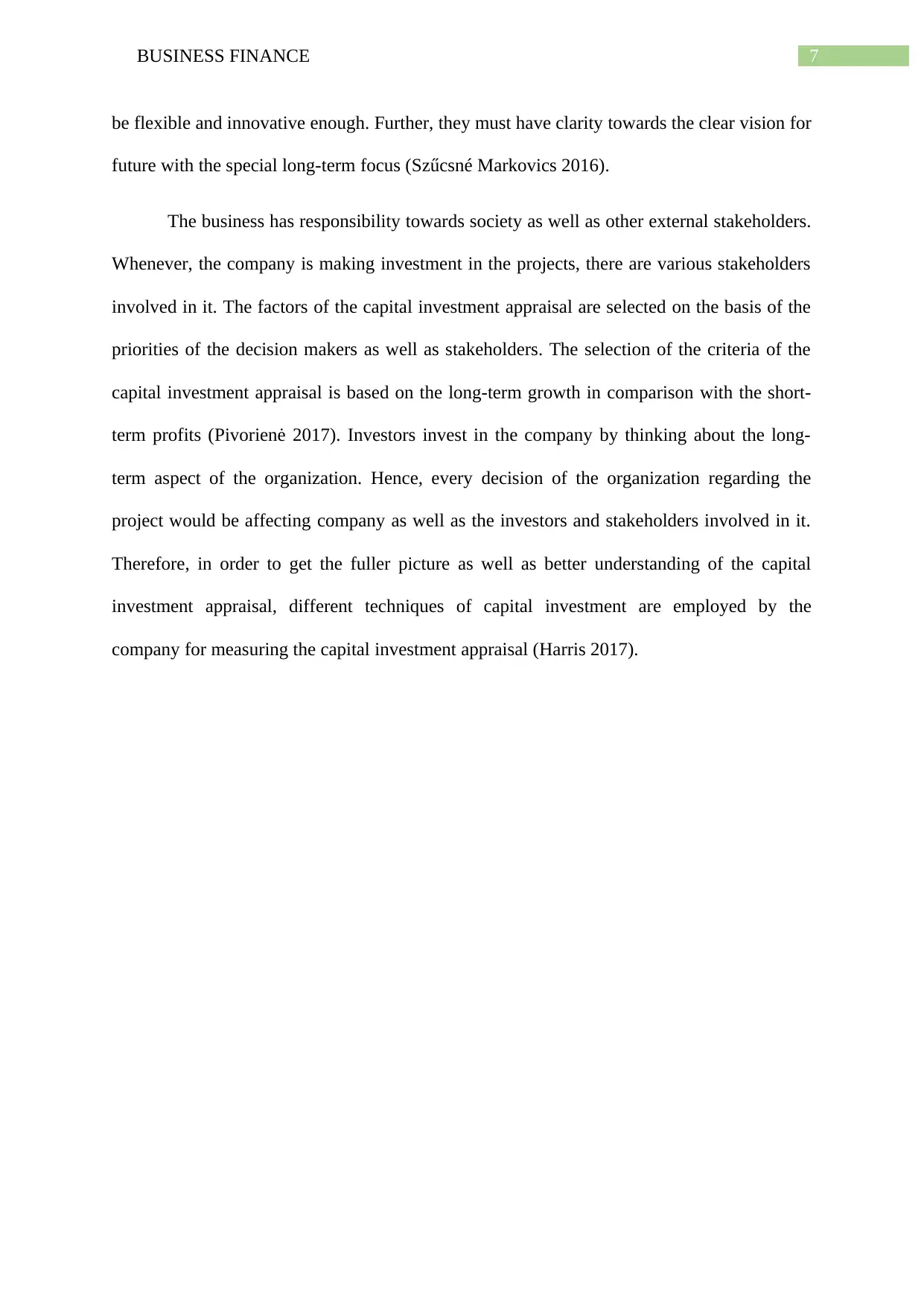
7BUSINESS FINANCE
be flexible and innovative enough. Further, they must have clarity towards the clear vision for
future with the special long-term focus (Szűcsné Markovics 2016).
The business has responsibility towards society as well as other external stakeholders.
Whenever, the company is making investment in the projects, there are various stakeholders
involved in it. The factors of the capital investment appraisal are selected on the basis of the
priorities of the decision makers as well as stakeholders. The selection of the criteria of the
capital investment appraisal is based on the long-term growth in comparison with the short-
term profits (Pivorienė 2017). Investors invest in the company by thinking about the long-
term aspect of the organization. Hence, every decision of the organization regarding the
project would be affecting company as well as the investors and stakeholders involved in it.
Therefore, in order to get the fuller picture as well as better understanding of the capital
investment appraisal, different techniques of capital investment are employed by the
company for measuring the capital investment appraisal (Harris 2017).
be flexible and innovative enough. Further, they must have clarity towards the clear vision for
future with the special long-term focus (Szűcsné Markovics 2016).
The business has responsibility towards society as well as other external stakeholders.
Whenever, the company is making investment in the projects, there are various stakeholders
involved in it. The factors of the capital investment appraisal are selected on the basis of the
priorities of the decision makers as well as stakeholders. The selection of the criteria of the
capital investment appraisal is based on the long-term growth in comparison with the short-
term profits (Pivorienė 2017). Investors invest in the company by thinking about the long-
term aspect of the organization. Hence, every decision of the organization regarding the
project would be affecting company as well as the investors and stakeholders involved in it.
Therefore, in order to get the fuller picture as well as better understanding of the capital
investment appraisal, different techniques of capital investment are employed by the
company for measuring the capital investment appraisal (Harris 2017).
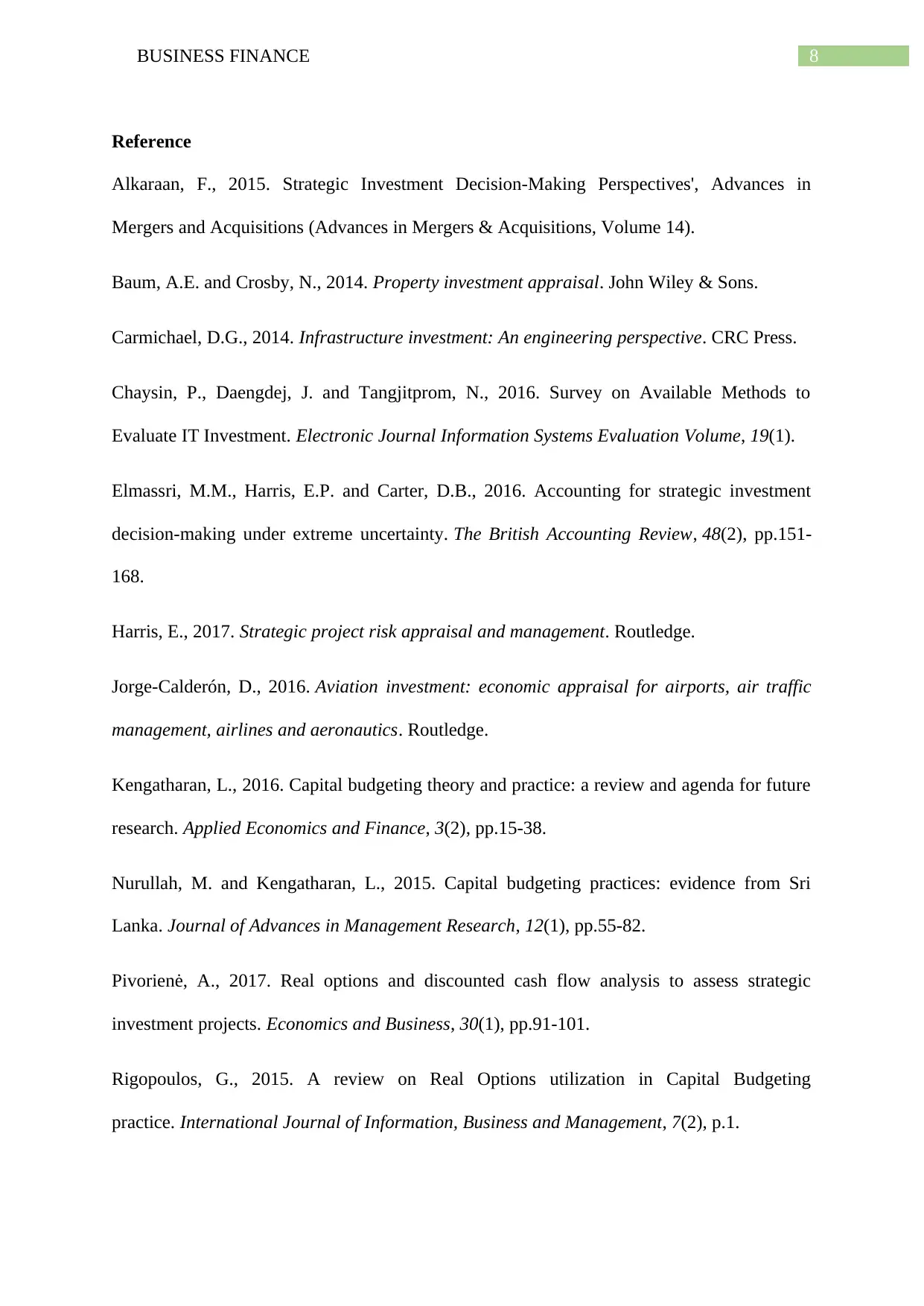
8BUSINESS FINANCE
Reference
Alkaraan, F., 2015. Strategic Investment Decision-Making Perspectives', Advances in
Mergers and Acquisitions (Advances in Mergers & Acquisitions, Volume 14).
Baum, A.E. and Crosby, N., 2014. Property investment appraisal. John Wiley & Sons.
Carmichael, D.G., 2014. Infrastructure investment: An engineering perspective. CRC Press.
Chaysin, P., Daengdej, J. and Tangjitprom, N., 2016. Survey on Available Methods to
Evaluate IT Investment. Electronic Journal Information Systems Evaluation Volume, 19(1).
Elmassri, M.M., Harris, E.P. and Carter, D.B., 2016. Accounting for strategic investment
decision-making under extreme uncertainty. The British Accounting Review, 48(2), pp.151-
168.
Harris, E., 2017. Strategic project risk appraisal and management. Routledge.
Jorge-Calderón, D., 2016. Aviation investment: economic appraisal for airports, air traffic
management, airlines and aeronautics. Routledge.
Kengatharan, L., 2016. Capital budgeting theory and practice: a review and agenda for future
research. Applied Economics and Finance, 3(2), pp.15-38.
Nurullah, M. and Kengatharan, L., 2015. Capital budgeting practices: evidence from Sri
Lanka. Journal of Advances in Management Research, 12(1), pp.55-82.
Pivorienė, A., 2017. Real options and discounted cash flow analysis to assess strategic
investment projects. Economics and Business, 30(1), pp.91-101.
Rigopoulos, G., 2015. A review on Real Options utilization in Capital Budgeting
practice. International Journal of Information, Business and Management, 7(2), p.1.
Reference
Alkaraan, F., 2015. Strategic Investment Decision-Making Perspectives', Advances in
Mergers and Acquisitions (Advances in Mergers & Acquisitions, Volume 14).
Baum, A.E. and Crosby, N., 2014. Property investment appraisal. John Wiley & Sons.
Carmichael, D.G., 2014. Infrastructure investment: An engineering perspective. CRC Press.
Chaysin, P., Daengdej, J. and Tangjitprom, N., 2016. Survey on Available Methods to
Evaluate IT Investment. Electronic Journal Information Systems Evaluation Volume, 19(1).
Elmassri, M.M., Harris, E.P. and Carter, D.B., 2016. Accounting for strategic investment
decision-making under extreme uncertainty. The British Accounting Review, 48(2), pp.151-
168.
Harris, E., 2017. Strategic project risk appraisal and management. Routledge.
Jorge-Calderón, D., 2016. Aviation investment: economic appraisal for airports, air traffic
management, airlines and aeronautics. Routledge.
Kengatharan, L., 2016. Capital budgeting theory and practice: a review and agenda for future
research. Applied Economics and Finance, 3(2), pp.15-38.
Nurullah, M. and Kengatharan, L., 2015. Capital budgeting practices: evidence from Sri
Lanka. Journal of Advances in Management Research, 12(1), pp.55-82.
Pivorienė, A., 2017. Real options and discounted cash flow analysis to assess strategic
investment projects. Economics and Business, 30(1), pp.91-101.
Rigopoulos, G., 2015. A review on Real Options utilization in Capital Budgeting
practice. International Journal of Information, Business and Management, 7(2), p.1.
⊘ This is a preview!⊘
Do you want full access?
Subscribe today to unlock all pages.

Trusted by 1+ million students worldwide
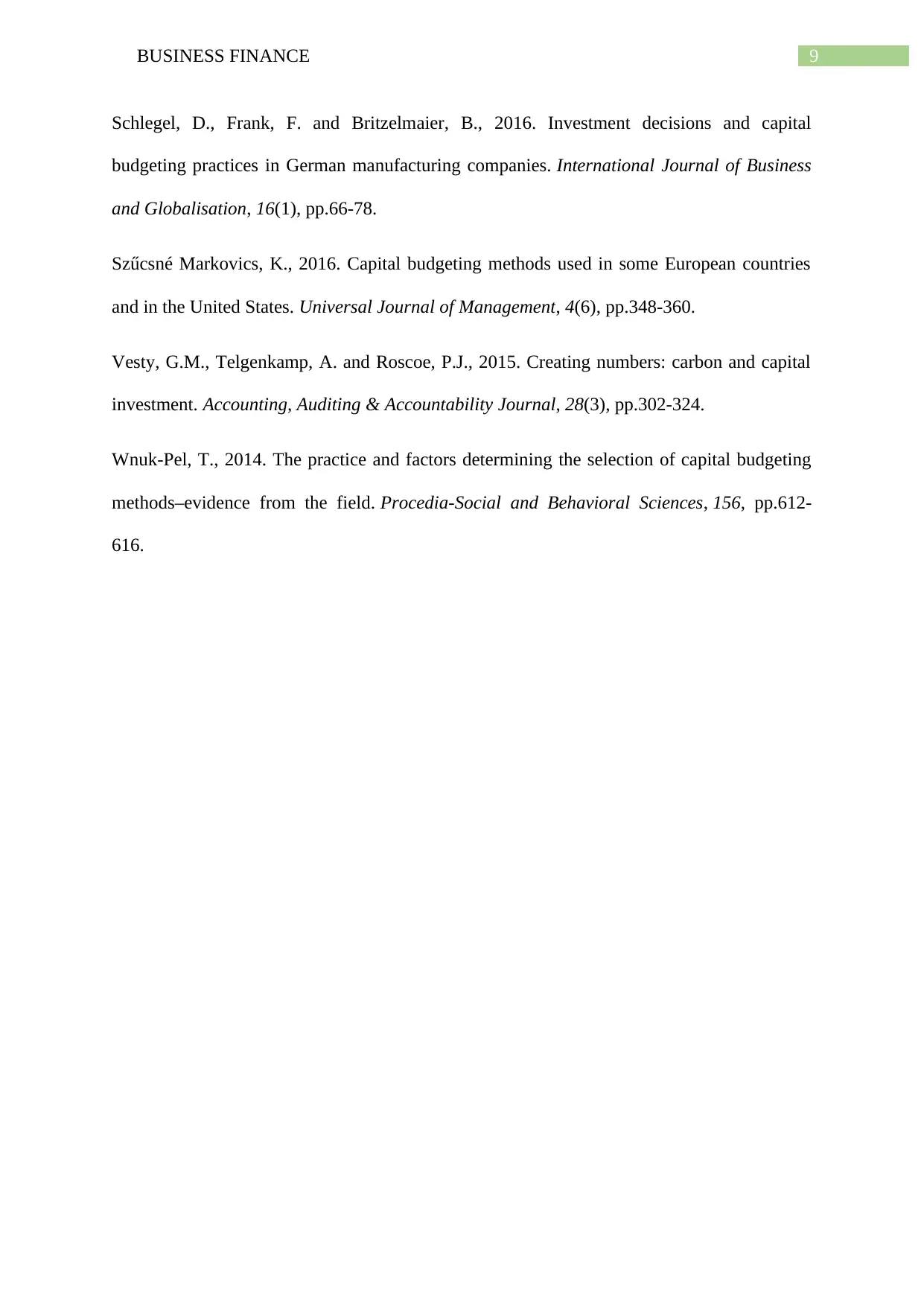
9BUSINESS FINANCE
Schlegel, D., Frank, F. and Britzelmaier, B., 2016. Investment decisions and capital
budgeting practices in German manufacturing companies. International Journal of Business
and Globalisation, 16(1), pp.66-78.
Szűcsné Markovics, K., 2016. Capital budgeting methods used in some European countries
and in the United States. Universal Journal of Management, 4(6), pp.348-360.
Vesty, G.M., Telgenkamp, A. and Roscoe, P.J., 2015. Creating numbers: carbon and capital
investment. Accounting, Auditing & Accountability Journal, 28(3), pp.302-324.
Wnuk-Pel, T., 2014. The practice and factors determining the selection of capital budgeting
methods–evidence from the field. Procedia-Social and Behavioral Sciences, 156, pp.612-
616.
Schlegel, D., Frank, F. and Britzelmaier, B., 2016. Investment decisions and capital
budgeting practices in German manufacturing companies. International Journal of Business
and Globalisation, 16(1), pp.66-78.
Szűcsné Markovics, K., 2016. Capital budgeting methods used in some European countries
and in the United States. Universal Journal of Management, 4(6), pp.348-360.
Vesty, G.M., Telgenkamp, A. and Roscoe, P.J., 2015. Creating numbers: carbon and capital
investment. Accounting, Auditing & Accountability Journal, 28(3), pp.302-324.
Wnuk-Pel, T., 2014. The practice and factors determining the selection of capital budgeting
methods–evidence from the field. Procedia-Social and Behavioral Sciences, 156, pp.612-
616.
1 out of 10
Related Documents
Your All-in-One AI-Powered Toolkit for Academic Success.
+13062052269
info@desklib.com
Available 24*7 on WhatsApp / Email
![[object Object]](/_next/static/media/star-bottom.7253800d.svg)
Unlock your academic potential
Copyright © 2020–2025 A2Z Services. All Rights Reserved. Developed and managed by ZUCOL.





